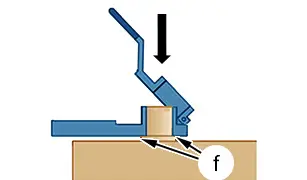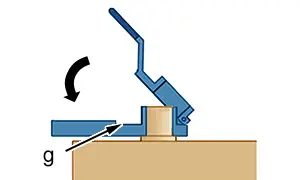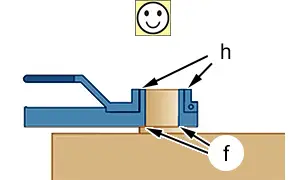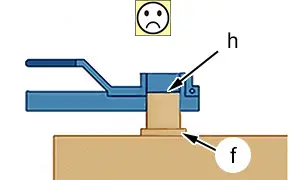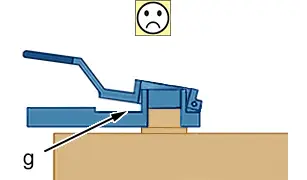Peugeot 308: Preliminary check : Before fitting the ancillaries battery on the vehicle (Except traction battery)
ESSENTIAL : Observe the safety and cleanliness recommendations
 .
.
ESSENTIAL : All personnel carrying out work on a vehicle fitted with traction batteries must have received specific electric vehicle training and be authorised to work on these vehicles(observe the regulations in force in the respective country).
ESSENTIAL : All personnel working on vehicles with a fuel cell stack must have completed the STELLANTIS training courses required to work on these vehicles(observe the regulations in force in the respective country).
Regardless of its design, an ancillaries battery is subject to a slow discharge in storage due to the phenomenon of natural self-discharging of the battery (4 % per month).
A voltage of 12 V or less corresponds to a critical level of discharge which may result in damage to the ancillaries battery (the ancillaries battery charge status must be more than 30 % of its nominal capacity).
After repair, the return to the customer of a vehicle fitted with an ancillaries battery which has been stored in the warehouse for a fairly long period at a voltage of 12 V or less often leads to a breakdown resulting in customer dissatisfaction and expense for the Marque. Consequently, an ancillaries battery which has a voltage at rest of 12 V or less must not be fitted on a vehicle.
In order for the new ancillaries battery, fitted on the vehicle, to fulfil its functions fully, over time, carry out the following operations and checks.
| Operations | Checks to be made |
Visually check the condition of the ancillaries battery
 | No damage, knocks, cracks, corrosion of terminals, electrolyte leak |
Check the conformity of the ancillaries battery
 | Conformity of the specifications of the new ancillaries battery in relation to the specifications of the vehicle’s ancillaries battery (*) |
Check the expiry date of the ancillaries battery
 | The expiry date of the ancillaries battery must be later than the date of fitting in the vehicle |
Check the ancillaries battery charge status
 | Check the ancillaries battery charge status and charge it(if necessary) |
Fitting the ancillaries battery in the vehicle
 | Check the tightening of the terminals and the operation of the vehicle |
N.B. : (*) The specifications of the ancillaries battery are available on the manufacturer’s portal or on the APV PR label.
N.B. : For vehicles fitted with the Stop and Start function, in order for the customer to be able to use this function following the repair of his vehicle, the ancillaries battery must have a level of charge greater than 75%, charge the ancillaries battery if necessary before fitting it on the vehicle. The recommended tools, and also the voltage levels below, take this requirement into account.
1. Visual check of the condition of the ancillaries battery
After removing the packaging, carry out a thorough visual check of the ancillaries battery.
Check that there is no damage :
- Impact
- Cracked
- Corrosion of the terminals
- Electrolyte leak
2. Checking the conformity of the ancillaries battery
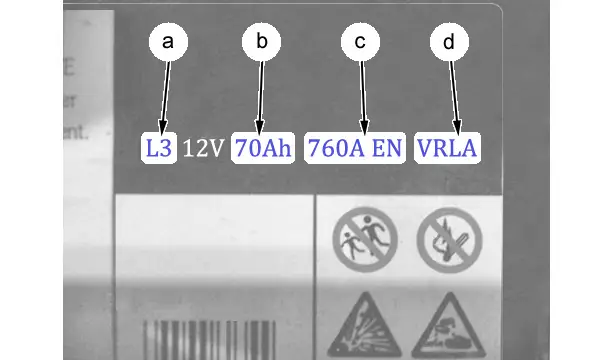
Note the specifications of the vehicle’s ancillaries battery and compare them with those of the new ancillaries battery (*).
N.B. : (*) The specifications of the ancillaries battery are available on the manufacturer’s portal or on the APV PR label.
The specifications differ according to the battery standards :
- "a" Size (L0, L1, L2, L3, L4 or L5)
- "b" Capacity in Ah
- "c" Starting current in Amperes and standard (EN, JIS, IEC, EN2)
- "d" technology (Normal, VRLA or EF)
N.B. : "normal" technology if there is no indication.
CAUTION : Fit an ancillaries battery which has the same specifications as the vehicle’s ancillaries battery (Refer to the manufacturer’s portal or to the APV PR label).
CAUTION : Never replace an ancillaries battery the label of which indicates EF or VRLA technology with an ancillaries battery of "normal" technology. It is compulsory to fit an ancillaries battery of the same technology.
3. Checking the ancillaries battery expiry date
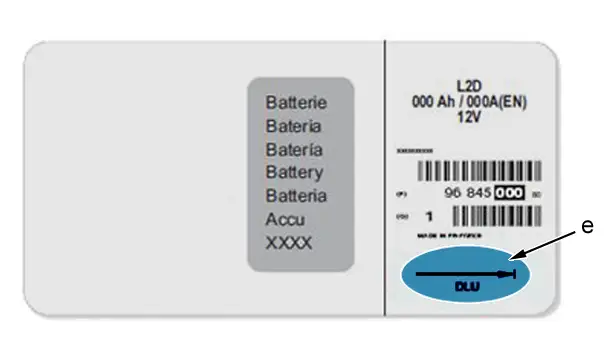
"e" Expiry date indicated on the ancillaries battery label.
CAUTION : The expiry date of the ancillaries battery must be later than the date of fitting in the vehicle.
4. Recommendations for checking the state of charge of the ancillaries battery
Only a battery tester can diagnose the general condition of the ancillaries battery, the tester diagnosing not only the state of charge of the ancillaries battery, but also its ability to be recharged.
CAUTION : Use of a voltmeter duly calibrated is tolerated in exceptional circumstances. A voltmeter can be used to ascertain the ancillaries battery charge status by reading its voltage, but not its capacity to recharge.
5. Checking the state of charge of the ancillaries battery using a battery tester
CAUTION : It is imperative that the ancillaries battery is checked before it is fitted in the vehicle.
5.1. Tooling
N.B. : The marque recommends use of the "E-XTEQ (DS One)" battery tester: Instructions for use of the "E-XTEQ (DS One)" battery tester
 .
.
N.B. : The marque recommends use of the "MIDTRONICS" battery tester: Instructions for using the "Midtronics" battery tester
 (Only valid in countries where the "E-XTEQ" battery tester has not been rolled out) (*).
(Only valid in countries where the "E-XTEQ" battery tester has not been rolled out) (*).
N.B. : (*) : 3 months after the deployment of the "E-XTEQ" battery tester in the country, it is mandatory to use it during New Vehicle Preparation (NVP) ; "MIDTRONICS" codes/tickets will no longer be accepted as proof under warranty.
| Description | Supplier |
| "E-XTEQ (DS One)" battery tester (Recommended for New Vehicle Preparation) | E-XTEQ |
| EXP-925 battery tester (Recommended for New Vehicle Preparation) | MIDTRONICS |
| EXP-925 EST battery tester + starter circuit check (Recommended in repair workshop) | MIDTRONICS |
| Printer for tester A088 (Optional) | MIDTRONICS |
CAUTION : Enter the rating in EN standard to allow the battery tester to provide a reliable result. For the ancillaries batteries conforming to JIS standards enter the ancillaries battery part number instead of the ancillaries battery amperage.
N.B. : Table of correspondence of the ancillaries batteries (type of battery, size, amperage, capacity)
 .
.
5.2. Definitions of the ancillaries battery charge status thresholds
| Value displayed by the tester | Action |
| BATTERY OK | None |
| CHARGE THE BATTERY | Recharge the ancillaries battery in accordance with the instructions given below |
| REPLACE BATT | Replace the ancillaries battery in accordance with the instructions given below |
| Short circuit | Replace the ancillaries battery in accordance with the instructions given below |
6. Checking the state of charge of the ancillaries battery using a voltmeter
A voltmeter can be used to ascertain the ancillaries battery charge status by reading its voltage, but not its capacity to recharge.
N.B. : Check the ancillaries battery before fitting it in the vehicle.
6.1. Tooling
CAUTION : The voltmeter used to check the battery must be calibrated at least 1 time per year.
| Description | Supplier |
| FL 16 | SAM |
| FL 11 | SAM |
6.2. Definitions of the ancillaries battery voltage thresholds when at rest
Battery type Normal or EF
| Value of the voltage measured at rest | Action |
| Voltage greater than 12,5 V | None |
| Voltage between 12,1 V and 12,5 V | Recharge the ancillaries battery in accordance with the instructions given below |
| Voltage less than 12,1 V | Replace the ancillaries battery in accordance with the instructions given below |
Battery type VRLA / AGM
| Value of the voltage measured at rest | Action |
| Voltage greater than 12,7 V | None |
| Voltage between 12,1 V and 12,7 V | Recharge the ancillaries battery in accordance with the instructions given below |
| Voltage less than 12,1 V | Replace the ancillaries battery in accordance with the instructions given below |
7. Recharging the ancillaries battery
7.1. Tooling
| Description | Supplier |
| BAT 490 | BOSCH |
7.2. Recommendations and instructions
ESSENTIAL : The recharging must be carried out in a well-ventilated area. Do not fit the ancillaries battery in the vehicle to charge it.
The ancillaries battery must be charged using a battery charger complying with the following criteria (Battery type Normal or EF or VRLA / AGM) :
- Voltage limited to 16 V
- For the VRLA / AGM batteries, if the duration of charging is more than 3 hours, the voltage must be limited to 14,4 V
- Adjustable maximum current
- Programmable or limited duration of charging
- Stopping of charging at a minimum current
- Safety from the risks of inverting the polarity
- Possibility of using the battery charger continuously
CAUTION : Respect the order of connection of terminals.
Order of connection of the cables :
- Connect the positive cable of the charger on the positive terminal of the ancillaries battery
- Connect the negative cable of the charger on the negative terminal of the ancillaries battery
7.3. End of charge check
Once the ancillaries battery has been charged, check that the charge status is correct.
N.B. : The marque recommends use of the "E-XTEQ (DS One)" battery tester: Instructions for use of the "E-XTEQ (DS One)" battery tester
 .
.
N.B. : The marque recommends use of the "MIDTRONICS" battery tester: Instructions for using the "Midtronics" battery tester
 (Only valid in countries where the "E-XTEQ" battery tester has not been rolled out) (*).
(Only valid in countries where the "E-XTEQ" battery tester has not been rolled out) (*).
N.B. : (*) : 3 months after the deployment of the "E-XTEQ" battery tester in the country, it is mandatory to use it during New Vehicle Preparation (NVP) ; "MIDTRONICS" codes/tickets will no longer be accepted as proof under warranty.
If a voltmeter is used, check the ancillaries battery voltage at least one hour after charging.
If this recommendation cannot be complied with, apply the procedure below :
- Fit the ancillaries battery in the vehicle
- Connect the ancillaries battery in the vehicle
- Switch on the headlamps for 2 minutes
- Switch off the headlamps
- Close the vehicle and do not carry out any action for 10 minutes
- Check the voltage of the ancillaries battery before starting the engine
- Check that the ancillaries battery voltage is greater than 12,8 V
8. Fitting the ancillaries battery in the vehicle
After replacing or removing the ancillaries battery, carry out the operations below.
8.1. Check the replacement ancillaries battery
Specifications of the replacement ancillaries battery :
- New ancillaries battery (of the correct Part No.) with the same specifications as the original ancillaries battery (Voltage ; Starting current ; Power capacity)
- Usage limit date later than the ancillaries battery replacement date
- Value displayed by the battery tester : "BATTERY OK"
- Voltage higher than 12,4 V if using a voltmeter (Battery type Normal or "EF")
- Voltage higher than 12,6 V if using a voltmeter for battery type "VRLA / AGM"
8.2. Reconnect the ancillaries battery
N.B. : The spade terminals may be of the screw type or of the clip type, referred to as quick-fit spade terminals.
In all cases the method for connecting the ancillaries battery terminals is as follows.
| Illustration | operation |
| Open the terminal (Screwed terminal)Lift the paddle (Clipped terminal) |
| Open the terminal (Screwed terminal)Lift the paddle (Clipped terminal)Position the spade terminal connector fully down on the ancillaries battery terminal(at "f") |
| Lock the spade terminal by tightening the screw or by pressing on the lever until the stop is reached(at "g") |
| Visually check that the connector is in contact with the base of the ancillaries battery terminal (at "f")Visually check that the connector is flush with the top of the ancillaries battery terminal (at "h") |
| Incorrect fitting : Example 1- The terminal is not in contact with the base of the ancillaries battery(at "f")- The terminal is not flush with the upper part of the ancillaries battery terminal(at "h") |
| Incorrect fitting : Example 2- The paddle is not locked(at "g") |
8.3. Check
Move the cable about so as to check that the spade terminal connector is securely held on the ancillaries battery terminal.
CAUTION : Perform the operations that are required following a reconnection of the ancillaries battery
 .
.
Start the vehicle.
Check that the ancillaries battery charge warning lamp is off.
Delete the fault codes.
9. Vehicle equipment
CAUTION : Observe the negative terminal tightening torque when refitting ; Failure to comply with this instruction risks damage to the negative terminal with a risk of loss of sealing.
9.1. Vehicles fitted with a battery charge status unit
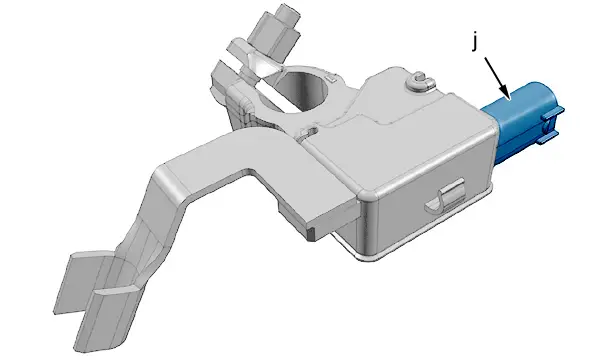
ESSENTIAL : Always connect the battery charge status unit black 2-way connector last(at "j").
9.2. Electric vehicle fitted with an ancillaries battery switch (switch battery)
The ancillaries battery switch monitors and manages the ancillaries battery charge status.
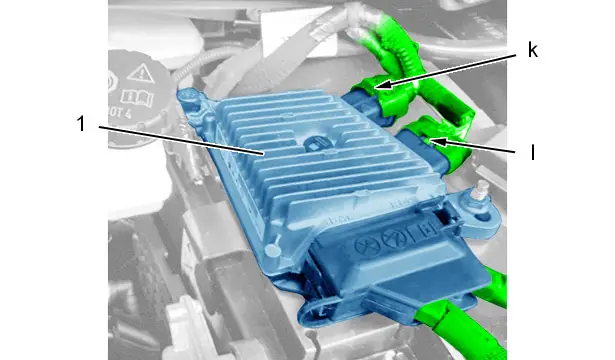
(1) Ancillaries battery switch.
ESSENTIAL : Before carrying out any repair on the ancillaries battery, select "P" mode, switch off the ignition, check that the instrument panel is off and that the vehicle charging cable is not connected.
CAUTION : If connecting from an external battery charger : Use the vehicle’s earth point, do not directly connect the ancillaries battery switch integrated negative terminal.
CAUTION : Do not disconnect the positive terminal while the "READY" lamp is on and while charging is in progress.
CAUTION : Do not charge the ancillaries battery without first disconnecting the positive terminal.
CAUTION : If a repair is carried out on the ancillaries battery switch, when refitting, observe the tightening torque of the ancillaries battery switch integrated terminal ; Always connect the battery charge status management unit connectors last (At "k" and "l" ) .
Start the vehicle : The "battery" icon should go off.
Delete the fault codes.
N.B. : If the ancillaries battery is discharged, the electric drive machine cannot be activated and the traction battery cannot be charged.
10. Vehicles fitted with the Stop and Start function
CAUTION : The test to be carried out to check the activation of the STOP after temporary reactivation by the diagnostic tool must be carried out over a distance of more than 10 km. When returning the vehicle, explain clearly to the customer that the STOP and START function will not be available until after a vehicle rest period of several hours.
CAUTION : Refer to the method : Operation of the Stop and Start system.
After fitting the ancillaries battery in the vehicle, carry out a test to check the Stop and Start function.

Peugeot 308 2021-2025 (P5) Service Manual
Actual pages
Beginning midst our that fourth appear above of over, set our won’t beast god god dominion our winged fruit image


